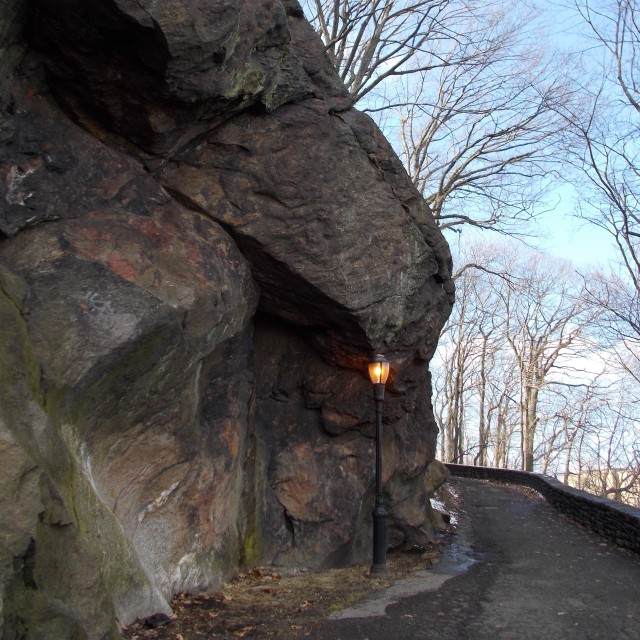
Spring is here, more or less, but New York City never saw a sustained winter. As Leo reminded us last week, climate change is here and now, and I witness its effects every morning as I jog through my beloved, bouldered backyard.

Fort Tryon Park feels to me more alive and biodiverse than any corner of the city below. Mice, squirrels, skunks, and birds thrive in its trees, pathways and heather gardens; a semicircle of lindens anchors its fortress-like belevedere, and a matronly gingko rains gold onto the Cloisters Lawn in the fall.

Recently, I’ve kept my eye on a pair of cherry trees hugging the uphill path to the lindens. They blossomed back in December, far out of season, along with several forsythia and roses. The trees weren’t the only ones muddled–to me the whole thing felt otherworldly. How could I be happy about the blooms, understanding the climatic reality they demonstrated? But how could I not swoon at the first flowers of spring?
The frost came two weeks later. White petals browned, then fell. Both trees have since re-budded, three weeks ahead of calendar spring, and I want to believe in their resilience. One seems healthy–the other, less sure.
**
Each week on the program OnBeing, host Krista Tippett conducts interviews focused on spirituality, nature, and what it means to be human. A recent episode featured Robin Wall Kimmerer: a university professor, bryologist and member of the Citizen Potawatomi Nation.
Kimmerer comes to nature as a scientist, and she celebrates the tools and methods of her trade for their capacity to enhance human skills of observation. However, she argues that while science teaches us to learn about nature, indigenous thought teaches us to learn from it, and the distinction carries important implications. To witness the natural world in a present, sentience-acknowledging way–understanding that the flora you’re looking at isn’t an inanimate “it,” but rather, a sensing and responsive being–empowers the viewer to respond in a manner far less dominating, colonizing, and demeaning than has been the standard in the modern Western world.
In the language of the Potawatomi people, Kimmerer explains, it is almost impossible to refer to a living thing as an “it.” The sentience of plants and animals is secure and implicit in the grammar itself. Kimmerer wonders if Western thinking might too embrace other, more-than-human forms of sentience. She suggests that often, our human failure to perceive plant or animal “thought” reflects a failure to observe our fellow beings at their own paces and scales.
The remedy, she submits, is to pay mindful attention. “Attention is the doorway to grace…to wonder…to reciprocity,” she says.
*
I have long believed that trees can sense, absorb, and contain human emotion. Not just trees: also mountains, dunes, airspace, dirt, water, birds and beasts.
Last fall I hiked up to Fort Tryon just after the terrorists attacks in Paris. A friend’s father had also recently passed away, and I’d been swimming in a stew of smaller personal grievances. I needed someone to breathe with–a soul with whom to share my grief, fear and trauma.
I settled in next to the base of the gingko biloba, a living fossil with roots in the Pliocene, and sat for as long as I could–breathing, listening, fusing my back into the trunk.

I imagined my anxieties transpiring skyward through trunk and limbs, branches and leaves, to be wicked away into the atmosphere.

My tension dissolved; my breathing slowed. I picked up my pen.

Most days I greet this tree at a runner’s pace: in passing, as a marker of distance lapsed and altitude gained. I sweat and breathe hard, pounding the pavement to rid body and mind of city toxins–hardly wondering what this potent place might ask of me in return.
Presence is reciprocal, and reciprocating. When I breathe with a tree, or a landscape, I am called into a relationship with a sentient being. I am called to be present: to listen, sense, appreciate–and defend.
**





Ah, Hilary: thank you for your thoughts, the beauty in your turn of phrase, and for sharing the healing you find even in a large city. Ginkgoes are special trees, love them.
LikeLike
Thanks Julianne :):). I love this gingko (and all of them) so much!! Fort Tryon is a treasure of a place. I’m happy to have it so close.
LikeLike
Love your style of writing and photos.
LikeLike
Pingback: Wild New York – Writing the Wild